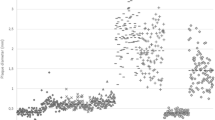Summary
A quantitative study of mouse virulence of ECHO virus type 9 strains, isolated from cases of aseptic meningitis was carried out using the plaque technique. Plaques obtained directly from ECHO virus type 9 isolates exhibited marked variation in mouse virulence; the majority of plaques was of high or low virulence, and only 3 out of 80 plaques tested were completely mouse avirulent. Subplating of these mouse avirulent plaques yielded strains which were predominantly mouse avirulent (45 out of 47 plaques). However, the passage in undiluted form of the avirulent plaque progeny in MKCC and especially in infant mice was selective for mouse virulence.
The rct/40 marker was employed for the study of mouse virulence of the ECHO virus type 9 strains. An excellent correlation was found between the rct/40 marker and mouse virulence; rct/40+ strains were mouse virulent whereas rct/40− strains were avirulent. The rct/40 marker is suggested for use in the determination of mouse virulence of ECHO virus type 9 isolates.
Similar content being viewed by others
References
Johnson, T.: A new clinical entity. Lancet272, 590 (1957).
Nihoul, E., L. Quersin-Thiry, andA. Weynants: ECHO virus type 9 as the agent responsible for an important outbreak of aseptic meningitis in Belgium. Amer. J. Hyg.66, 102–118 (1957).
McLean, D. M., andJ. L. Melnick: Association of mouse pathogenic strain of ECHO virus type 9 with aseptic meningitis. Proc. Soc. exp. Biol. (N. Y.)94, 656–660 (1957).
Quersin-Thiry, L., E. Nihoul, andF. Dekking: ECHO virus type 9 (new member of Coxsackie group type A) as a cause of epidemic meningitis. Science125, 744–745 (1957).
Boissard, G. P. B., A. D. Macrae, J. L. Stokes, andF. O. MacCallum: Isolation of viruses related to ECHO virus type 9 from outbreaks of aseptic meningitis. Lancet272, 500–502 (1957).
Ramos-Alvarez, M., andA. B. Sabin: Characteristics of poliomyelitis and other enteric viruses recovered in tissue culture from healthy American children. Proc. Soc. exp. Biol. (N. Y.)87, 655–661 (1954).
Ramos-Alvarez, M., andA. B. Sabin: Intestinal viral flora of healthy children demonstrable by monkey kidney tissue culture. Amer. J. publ. Hlth46, 295–299 (1956).
Rannon, L., N. Goldblum, Z. Leventon, M. Levi, J. Farin, andW. Pushkin: An outbreak of ECHO 9 disease in Israel. Harefuah, J. med. Ass. Israel57, 115–118 (1959).
Goldblum, N., andL. Rannon: Virulence for infant mice of ECHO virus type 9 strains. Bull. Res. Coun., Israel E8, 63–64 (1959).
Ashkenazi, A., andI. Yodfat: An outbreak of an epidemic due to ECHO 9 in a kibbutz. Harefuah, J. med. Ass. Israel67, 289–291 (1964).
Godtfredsen, A., andH. von Magnus: Isolation of ECHO virus type 9 from cerebrospinal fluids. Dan. med. Bull.4, 233–236 (1957).
Tyrrell, D. A. J., andB. Snell: Recovery of a virus from cases of an epidemic exanthem associated with meningitis. Lancet271, 1028–1029 (1956).
Laforest, R. A., G. A. McNaughton, A. J. Beale, M. Clarke, N. Davis, I. Sultanian, andA. J. Rhodes: Outbreak of aseptic meningitis (meningo-encephalitis) with rubelliform rash: Toronto, 1956. Canad. med. Ass. J.77, 1–4 (1957).
Eggers, H. J., andA. B. Sabin: Factors determining pathogenicity of variants of ECHO 9 virus for newborn mice. J. exp. Med.110, 951–967, (1959).
Sabin, A. B., E. R. Krumbiegel, andR. Wigand: ECHO type 9 virus disease. Virologically controlled clinical and epidemiologic observations during 1957 epidemic in Milwaukee with notes on concurrent similar diseases associated with Coxsackie and other ECHO viruses. Amer. J. Dis. Child.96, 197–219 (1958).
Wigand, R., andA. B. Sabin: Properties of epidemic strains of ECHO type 9 virus and observations on the nature of human infection. Arch. ges. Virusforsch.11, 683–707 (1962).
Lwoff, A.: Factors influencing the evolution of viral diseases at the cellular level and in the organism. Bact. Rev.23, 109–124 (1959).
Sabin, A. B.: Reproductive capacity of polioviruses of diverse origins at various temperatures. “Perspectives in Virology” Vol. II. Burgess, Minneapolis, 90–108 (1961).
Dulbecco, R., andMarguerite Vogt: Plaque formation and isolation of pure lines with poliomyelitis viruses. J. exp. Med.99, 167–182 (1954).
Youngner, J. S.: Virus yield per cell in monkey kidney cultures inoculated with different strains of poliomyelitis virus. J. Immunol.76, 50–53 (1956).
Reed, L. J., andH. A. Muench: A simple method of estimating fifty percent end point. Amer. J. Hyg.27, 493–497 (1938).
Miriam Margalith, Eva Margalith, andN. Goldblum: Unpublished results.
Author information
Authors and Affiliations
Rights and permissions
About this article
Cite this article
Margalith, M., Margalith, E., Rannon, L. et al. Segregation of mouse virulent and avirulent ECHO virus type 9 strains and the correlation of mouse-virulence with the “temperature” (rct/40) marker. Archiv f Virusforschung 21, 403–412 (1967). https://doi.org/10.1007/BF01241739
Received:
Issue Date:
DOI: https://doi.org/10.1007/BF01241739




